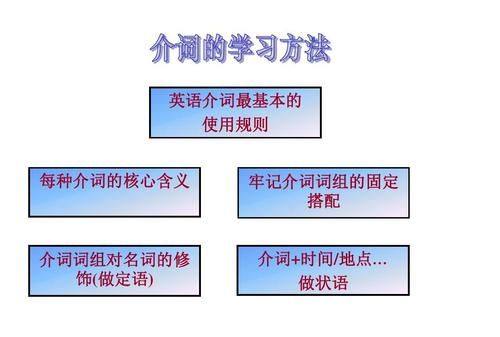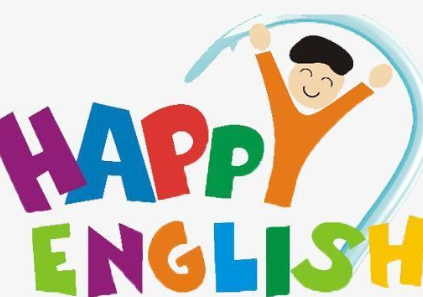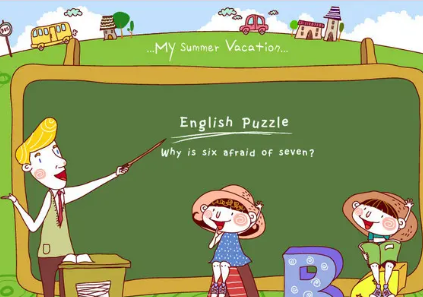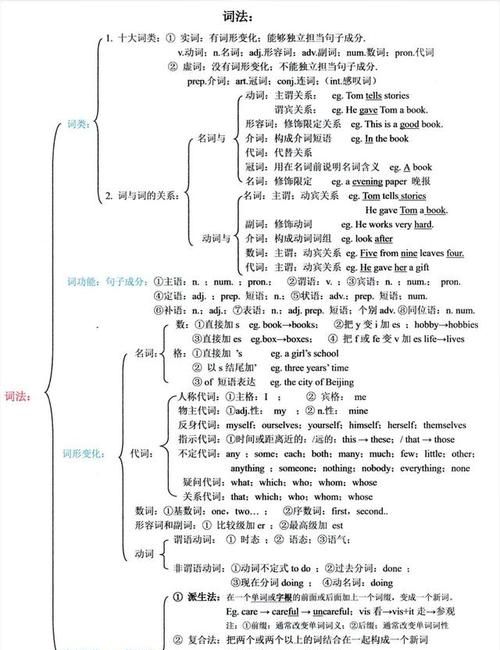本文目录
初中英语语法填空技巧整理万能公式来袭
初中英语语法填空想要得高分,就要掌握万能公式。下面我整理了相关内容,供大家参考。
英语语法填空解题技巧
语法填空题是给出200字左右的一段短文或对话,段落中给出10个填空,其中几个填空是给出一个单词,填写它的正确词形,如形容词的比较级等,在考试说明的样题中给出提示词的空共有4个,其余填空是结合上下文直接填词,这要求考生既要掌握熟练的语法知识,还要有一定的语言阅读能力。
初中英语语法填空分为两种考查形式,即横线后有提示词,和横线后无提示词。有提示词:考生要运用根据单词的适当形式填空的技巧。无提示词:可填词性:介词、代词、连词、冠词、情态动词。
初中英语语法填空一般考察动词过去式,时间状语从句引导词,过去分词,形容词副词比较级,动词与动名词的动宾搭配,连词,代词it,冠词,情态动词表推测,动词短语习惯搭配。
初中英语语法答题万能公式
1.已给单词提示题型的公式
(1)名词的形式变化主要有单数、复数、所有格的变化。
(2)动词的形式变化比较多,有谓语的变化(时态、语态、语气),有非谓语的变化(不定式、动名词、现在分词、过去分词)。
(3)代词形式变化通常是与人称变化有关的三大类五小类,即人称代词(主格和宾格)、物主代词(形容词性和名词性)、反身代词。另外还有几个不定代词的形式变化,如no one/none、other/another等。
2.未给单词提示题型的公式
(1)根据句中横线前后及整句来判断横线前后是否构成一个固定短语,但有时要对横线前或后的几个单词“视而不见”才能命中答案。
(2)短语动词是以动词为中心的两个或多个词构成的短语,此类短语中往往是动词与介词或副词连用的多些。
(3)冠词只能是在a,an,the之间判断;常用的介词有in,at,on,before,during等,通常考查固定搭配;副词的量还是比较多,如:however,never,yet,much等。

高中英语语法填空万能公式
英语语法填空万能公式有如下这些:
一、名词形式变化
名词的形式变化主要有单数、复数、所有格的变化。
例如:There are many students living at school,the (child) houses are all far from schoo1.由students一词可以判断出横线处应填复数,且作为houses的定语,所以应用其所有格形式,故答案为child的复合变化形式——复数的所有格children’s。

二、动词形式变化
动词的形式变化比较多,有谓语的变化(时态、语态、语气),有非谓语的变化(不定式、动名词、现在分词、过去分词)。
例如:A talk (give) tomorrow is written by Professor Zhang.句中的is written是整句的谓语,所以横线所在的动词应当用作非谓语。从tomorrow可以看出,报告是“将来”作的,故用不定式;且报告是give动作的承受者,故可以判断出横线所在处用give的不定式被动式——to be given。

三、代词形式变化
代词形式变化通常是与人称变化有关的三大类五小类,即人称代词(主格和宾格)、物主代词(形容词性和名词性)、反身代词。另外还有几个不定代词的形式变化,如no one/none、other/another等。

四、形容词、副词比较级变化
英语中大部分形容词和表方式的副词都有原级、比较级和最高等的变化。构成比较级和最高级的方式,或通过加后缀一er和.est,或在词前加more/less和most/least,且形容词的最高级还要冠以the。

五、并列连词和从句引导词
从句是此题型最为常见的一个方向,主要检测学生对三大从句引导词的掌握程度。若两个句子(即两个主谓结构)之间没有连词,也没有分号或句号,一定是填并列连词but ,and ,or ,或so连接并列的句子或从属连词(连接定语从句、名词性从句和状语从句的)。

一到六年级英语公式大全
ring 响——rang——ringing
run 跑——ran——running
say 说——said——saying
see 看见——saw——seeing
sing 唱歌——sang——singing
sit 坐——sat——sitting
sleep 睡觉——slept——sleeping
speak 讲话——spoke——speaking
spend 花钱——spent——spending
stand 站立——stood——standing
sweep 打扫——swept——sweeping
swim 游泳——swam——swimming
take 拿到——took——taking
teach 教——taught——teaching
tell 讲述——told——telling
think 思考——thought——thinking
will 意愿——would——无 回答者: 飘吧love兰 | 二级 | 2011-5-2 18:41 | 检举
时态
1、一般现在时
(1)一般现在时中的be动词:
一般用原形:am is are
am用于第一人称单数(I);is用于第三人称单数(he she it和其他人名或称谓,如:Ben his sister等);are用于第二人称单数(you)和所有复数(包括第一人称复数we、第二人称复数you;第三人称复数they和其他复数,如the children 、 his parents等)。
(2)一般现在时中的动词:
第一种情况:主语是第三人称单数(he she it 和其他,如Helen 、her cousin 等),动词后一般加s或es。
第二种情况:主语不是第三人称单数,动词都用原形。
(4)一般现在时判断依据(如何判断一个句子是一般现在时):
△be动词是am、is、are
△动词用原形或加s、es
△没有时间状语或有usually、often、everyday、sometimes等不是具体的时间
2、一般过去时
(1)一般过去时中的be动词:
一般用过去式:was were
was用于第一人称单数(I)和第三人称单数(he she it和其他人名或称谓,如:Ben 、 his sister等);were用于第二人称单数(you)和所有复数(包括第一人称复数we、第二人称复数you;第三人称复数they和其他复数,如the children 、 his parents等)。
(2)一般过去时中的动词:
一般只有一种情况:+ed
这里强调一点,和一般现在时不同的是这里不管主语是第几人称,也不管是单数和复数都加ed。
(4)一般过去时判断依据(如何判断一个句子是一般过去时):
△be动词是was、were △动词加ed
△有表示过去的时间状语
现在学过的常用的表示过去的时间状语有:
just now a moment ago yesterday last week last night
last weekend last year last month three days ago two weeks ago
five years ago this morning
3、一般将来时
(1)构成形式:
Be going to +动词原形, will + 动词原形
(2)一般将来时表示动作即将发生或某人打算做某事。
(3)句中往往有tomorrow、soon、next week等词。
4、现在进行时
(1)构成形式:
Be动词+动词的ing形式
这里强调一点,两者缺少其中任何一种都不可以构成现在进行时。
(2)现在进行时表示动作正在进行或事情正在发生。
(3)有用的依据:
一个句子中既有be动词,又有动词,且动词加了ing ←→ 该句是现在进行时
(4)句中往往有now、look、listen等词。
动词过去式、现在分词的不规则变化:
be 是——was, were——being
begin 开始——began——beginning
build 建筑——built——building
buy 买——bought——buying
can 能——could——无
come 来——came——coming
copy 拷贝——copied——copying
do 做——did——doing
draw 画——drew——drawing
drink 喝——drank——drinking
drive 驾车——drove——driving
eat 吃——ate——eating
feel 感觉——felt——feeling
find 找寻——found——finding
fly飞——flew——flying
forget 忘记——forgot——forgetting
get 得到——got——getting
give 给予——gave——giving
go 去——went——going
grow 成长——grew——growing
have 有——had——having
hear 听——heard——hearing
keep 保持——kept——keeping
know 知道——knew——knowing
learn学习—learnt, learned——learning
let 让——let——letting
make 做——made——making
may 可以——might——无
mean 意思——meant-meaning
meet 见面——met——meeting
must 必须——must——无
put 放——put——putting
read 读——read——reading
ride 骑——rode——riding
ring 响——rang——ringing
run 跑——ran——running
say 说——said——saying
see 看见——saw——seeing
sing 唱歌——sang——singing
sit 坐——sat——sitting
sleep 睡觉——slept——sleeping
speak 讲话——spoke——speaking
spend 花钱——spent——spending
stand 站立——stood——standing
sweep 打扫——swept——sweeping
swim 游泳——swam——swimming
take 拿到——took——taking
teach 教——taught——teaching
tell 讲述——told——telling
think 思考——thought——thinking
will 意愿——would——无
write 写——wrote——writing
一、词类:
1、动词:行为动词、be动词、情态动词。
(1)行为动词
原形、+s/es、+ed、+ing,具体判断方法如下:
(2)be动词
a、Am--was Is --was Are--were 口诀:我用am, 你用are, is用在他她它,所有复数全用are。
b、肯定和否定句
I am (not) from London. He /She is(not) a teacher. My hair is(not) long. Her eyes are(not) small.
c、 一般疑问句 Am I …? Yes, you are. No, you aren’t. Are you/they…? Yes,we/ they are. No,we/ they aren’t. Is the cat fat? Yes, it is. No, it isn’t.
is、am、are为一类,一般用于一般现在时、现在进行时和一般将来时中。
was和were为另一类,一般用于一般过去时。
(3)情态动词
can、must、should、would、may。情态动词后动词总是用原形。(不受其他任何条件影响)
2、名词
这里强调两点:不可数名词都默认为单数,所以总是用is或者was。
如何加后缀:
a.一般情况下,直接加-s,如:book-books, bag-bags, cat-cats, bed-beds
b.以s. x. sh. ch结尾,加-es,如:bus-buses, box-boxes, brush-brushes, watch-watches
c.以“辅音字母+y”结尾,变y为i, 再加-es,如:family-families, strawberry-strawberries
d.以“f或fe”结尾,变f或fe为v, 再加-es,如:knife-knives
e.不规则名词复数: man-men, woman-women, policeman-policemen, policewoman-policewomen, mouse-mice child-children foot-feet ,.tooth-teeth fish-fish, people-people, Chinese-Chinese, Japanese-Japanese
3、形容词(包括副词)
形容词表示某一事物或的特征,副词表示某一动作的特征。
形容词和副词只有两种形式:原形和+er。
未作比较的情况下就用原形,比较时就+er。
两个重要特征:as……as中间一定用原形,有than的时候一定+er。
4、人称代词和物主代词
人称代词
物主代词
单数
复数
单数
复数
主格
宾格
主格
宾格
形容词性(短)
名词性(长)
形容词性(短)
名词性(长)
第一人称
I
me
we
us
my
mine
our
ours
第二人称
you
you
you
you
your
yours
your
yours
第三人称
he
him
they
them
his
his
their
theirs
she
her
her
hers
it
it
its
its
人称代词:
有主格和宾格之分。
一般动词前用主格,动词后用宾格。
物主代词:
有两类:形容词性物主代词(短的)和名词性物主代词(长的)
一般看后面有没有名词,如有,就用形容词性物主代词(短的);如无,就用名词性物主代词(长的)。
5、数量词
我们学过两类:基数词和序数词。基数用于表示数量多少,而基数词用于表示次序,常在日期中出现。序数词的前面一般都加the。
6、冠词
有a、an、the。a和an的区别:an用于元音音素(一般就是元音字母aeiou)前,a用于辅音音素前。
二、否定句:
be动词(am、is、are、was、were)+not、
情态动词(can、must、should)+ not、
助动词(do、does、did) + not
如何将一个肯定的陈述句改为否定句:
1、看句中有无be动词,如有,直接在be动词后+ not。
2、看句中有无情态动词,如有,直接在情态动词后+ not。
3、如上述二者都没有,就应用助动词+ not。分四个步骤:
(1)肯定陈述句中本来是没有助动词的,要加上去,位置在主语(某人或某物)后,动词前。
(2)确定助动词用do、does还是did,根据句中动词,动词是原形的助动词就用do,动词是第三人称单数的助动词就用does,动词用过去式的助动词就有did。
(3)在助动词后加not。
(4)原句中动词假如发生变化就要恢复成原形。
强调一点,有some的要考虑是否要用any。
三、一般疑问句。
如何将一个肯定的陈述句改为否定句:
1、看句中有无be动词,如有,把be动词提到句首即可。
2、看句中有无情态动词,如有,把情态动词提到句首即可。
3、如上述二者都没有,就应把助动提到句首。分四个步骤:
(1)肯定陈述句中本来是没有助动词的,要加上去,位置在主语(某人或某物)后,动词前。
(2)确定助动词用do、does还是did,根据句中动词,动词是原形的助动词就用do,动词是第三人称单数的助动词就用does,动词用过去式的助动词就有did。
(3)把助动词后提到句首。
(4)原句中动词假如发生变化就要恢复成原形。
强调一点,有some的要考虑是否要用any。 参考资料:好好复习吧!我相信你哦!把分给我吧

英语语法公式归纳总结
英语语法公式
1 (see 、hear 、notice 、listen to 、look at (感官动词)+do ing
4 agree with sb 赞成某人
11 ask sb for sth 向某人什么
12 ask sb to do sth 询问某人某事 ask sb not to do 叫某人不要做某事
17 be /feel confident of sth /that clause +从句感觉/对什么有信心,自信 18 be + doing 表:1 现在进行时 2 将来时 20 be able to do sth 能够干什么
21 be afraid to do (of sth 恐惧,害怕……
22 be allowed to do 被允许做什么
23 be angry with sb 生某人的气
24 be angry with(at) sb for doing sth 为什么而生某人的气
29 be bad for 对什么有害 30 be busy with sth 忙于……
31 be busy doing sth 忙于做什么事
32 be careful 当心;小心
33 be different from…… 和什么不一样
34 be famous for 以……著名
35 be friendly to sb 对某人友好 36 be from = come from 来自
37 be full of 装满……的 be filled with 充满
38 be glad+to+do/从句 39 be going to + v(原) 将来时
40 be good at(+doing) = do well in 在某方面善长, 善于……
41 be good for 对什么有好处
42 be happy to do 很高兴做某事
43 be helpful to sb 对某人有好处
44 be in good health 身体健康
45 be in trouble 处于困难中
46 be interested in 对某方面感兴趣
47 be late for = come late to 迟到
48 be like 像……
49 be mad at 生某人的气
50 be made from 由……制成(制成以后看不见原材料)
51 be made of 由……制成(制成以后还看得见原材料)
52 be not sure 表不确定
53 be on a visit to 参观
54 be popular with sb 受某人欢迎
55 be quiet 安静
58 be sorry to do sth be sorry for sb
59 be sorry to hear that 60 be sorry to trouble sb
61 be strict in doing sth 严于做某事
62 be strict with sb 对某人要求严格
63 be strict with sb in sth 某方面对某人严格
64 be supposed to do 被要求干什么
65 be sure 表确定 66 be sure of doing sth 对做某事有信心
67 be sure of sth 对做某事有信心 68 be sure that sth 对做某事有信心
69 be sure to do sth一定会做某事
70 be terrified of + 名/动doing 害怕……
71 be terrified to do sth 害怕做某事
72 be the same as … 和什么一样
73 be used to doing sth 习惯做某事
74 be worth doing 值得做什么
75 be(feel) afraid to do sth 害怕做某事be afraid of sth 害怕某物 be afraid that 丛句
76 because+句子 because of +短语
77 begin to do = start to do 开始做某事 start…with…=begin…with… 以什么开始什么
79 borrow sth from sb 向……借…… lend sth to sb ( lend sb sth 借给……什么东西
80 both = the same(as) = not different(from) 表相同
81 bother 打扰 bother sb to do sth
82 by the end of 到……为止
85 catch up with sb 赶上某人
86 chat with sb 和某人闲谈 take sb to + 地点 带某人去某地
89 come up with 提出
90 communicate with sb 和某人交流
91 consider + doing 考虑做什么
93 decide to do sth 决定做某事 94 do a survey of 做某方面的调查
95 do better in 在……方面做得更好
97 Don't forget to do sth 不要忘了做某事
98 Don't mind +doing /从句 /名词 不要介意……
99 each +名(单)每一个…
100 end up +doing
101 enjoy +doing喜欢
102 escape from 从……逃跑
103 expect to do sth 期待做某事
105 fall in love with sb /sth 爱上什么
107 find +it +adj +to do 发现做某事怎么样
108 find sb/sth +adj 发现什么怎么样
109 finish 完成+doing(名词)
110 fit to sb = be fit for sb 适合某人
112 from…to… 从某某到某某
113 get /have sth down 做完,被(别人)做…
114 get a part-time job= find a part-time job
115 get along well with sb = get on well with sb 与某人相处得好
116 get along with sb = get on with sb 与某人相处
119 get sb to do sth
120 get…from… 从某处得到某物
122 give sth to sb give sb sth 给某人某物
124 go on to do 去做下一件事 go on doing 继续做这件事
125 go out away from go out of
131 have been doing 现在完成进行时
132 have been to …( 地方)……去过某过地方
have gone to …(地方) 去了某地还没回来
133 have fun +doing 玩得高兴
134 have sth to do 有什么事要做
135 have to do sth 必须做某事
136 have trouble (problem) (in) doing sth 做什么事情有麻烦
137 have…time +doing
139 hear sb +do/doing 听见某人做某事/正在做某事
140 help a lot 很大用处
141 help sb with sth \one's sth 帮助某人某事(某方面)
help sb (to) do sth 帮助某人做某事
142 hope to do sth 希望做某事
143 How about(+doing) = What about(+doing)
154 introduce sb to sb 介绍某人给某人 introduce oneself 自我介绍
155 invite sb to do sth 邀请某人做某事
156 It takes sb sometime to do sth 做某人花掉某人多少时间
157 It's +adj +for sb to do sth 对某人来说做某事怎么样
158 It's +adj +to do 做某事怎么样
159 It's +adj for sb 对于某人来说怎么样 It's +adj of sb 对某人来说太怎么样
160 It's +adj(for sb) to do(对某人来说) 做某事怎么样
It's +adj of sb to do sth 对某人来说做某事太怎么样
161 It's a good idea for sb to do sth 对…… 来说是个好主意
162 It's important to sb 对某人来说很重要
163 It's time to do sth It's time for sth 到了该去做某事的时间
166 keep +sb /sth +adj /介词短语 让什么保持什么样?
173 learn from sb 向某人学习
174 learn to do sth 学做某事
175 let sb do sth 让某人做某事
176 Let sb down 让某人失望
177 live from :离某地远
178 live in +大地方 /at +小地方 居住在某地
179 look after = take care of 照顾 照看
181 make a decision to do sth 决定做某事
182 make friends with sb 和谁成为朋友
183 make it early 把时间定的早一点
184 make on exhibition of oneself 让某人出洋相
185 make sb /n +n 使什么成为什么
186 make sb /sth +adj 使某人(某物)怎么样
187 make sb /sth adj 使某人/某物怎么样 188 make sb do sth 让某人做某事
189 make up be made up of (被动语态)由……组成
191 mind sb to do mind one's doing 介意……做什么
192 most +名 most of +代
193 much too +形容词
194 must be 一定 195 need +名词
196 need sb do sth 需要某人做某事
197 need to do (实义动词) need do (情态动词)
198 no /neithr of hate to do no /neithr of hate doing
199 no +名词
202 not…at all 一点都不
204 not…until 直到……才……
205 offer / provide sb with sth 给某人提供
206 offer sb sth ( offer sth to sb 提供什么东西给某人
207 on one's way to… 在谁去那的路上
208 on the one hand 一方面 on the other hand 另一方面
209 on the phOne= over the phone 用电话交谈
210 on time 准时 in time 及时
212 one of +可数名词的复数形式
213 one to another 一个到另一个
214 over and over agin 一遍又一遍的
215 part-time job 兼职工作 fall-time job 全职工作
216 pay for… 付……钱 pay the bill 开钱 ,付钱 217 please +do
219 pleased with sb
220 pool into = pore into
221 practice +doing 练习做某事
222 prefer sth to sth 相对……更喜欢……
prefer doing to sth 更喜欢去做…不愿意去做…
prefer to do sth rather than do sth 宁愿做…也不愿 prefer sb not to do sth 更愿意…
223 pretend to do sth 装着去做什么 pretend that 从句
224 rather…than 宁可……也不…… 225 regard…as 把……当作……
226 remid sb about sth 提醒某人什么事
remid sb to do sth 提醒某人做某事
227 remid sb of sth 使某人想起什么
228 return sth to sb 还什么东西给某人
231 sb spend somemoney on sth 花了多少钱在某事上
232 sb spend sometime with sb 花了多少时间陪谁
233 sb spend sometime(in) doing sth 花了多少时间做某事
234 sb with sb +is sb and sb +are
235 see sb do 看见某人做过某事
see sb doing 看见某人正在做某事
236 seem to do/be +adj 显得怎么样
237 send +sb sth 送给某人某物
238 send…to…把什么寄到哪里去?
239 shock 使……震惊
240 show sb sth 向某人展示某物
241 show sb sth = show sth to sb 拿什么东西给某人看
242 show sth to sb 向某人展示某物
245 stay away from 远离……
246 stop doing 停下正在做的事
247 stop sb from doing sth 阻止某人做某事
248 stop sb(from) doing 阻止某人做某事
249 stop to do 停下正在做的事去做下一件事
250 such +名 这样 ,这种
251 suit sb 适合某人
252 surprise sb 使某人惊奇 to one's surprise 令某人惊奇
253 take classes 上课
254 take sb to 把某人带去
257 talk with sb 和某人说话
258 teach sb sth 教某人做某事
259 tell sb do sth 告诉某人做某事
261 tell sb sth 告诉某人某事
262 tell sb to do sth 告诉某人做什么
tell sb not to do sth 告诉某人不要做什么
264 thank you for +doing
265 the same +名词(doing)+as……
267 the way to do sth = the way of doing st做某方面 的方法
the way to +地方 去哪的路
268 the way to…(地点) 到哪的
269 too…to… 太怎样而不能……adj +enough to 足够…能… so…that +丛句
270 transalte ……into…… 把什么翻译成什么
271 travel with sb和某人去旅游
272 try one's best to do sth尽某人最大的努力去做某事
273 try to do sth 想干什么,但没成功
try doing sth 想干什么,已经做过了
274 try…试衣服 have a try 试一下
275 turn down/up 开小/开大
276 turn off/ on 关上/打开 open 拆开
277 upside down 倒着
278 visit to… 参观某个地方
279 wait for sb 等某人
【来自百度文库】

以上就是关于68英语语法公式 ,初中英语语法填空技巧整理万能公式来袭的全部内容,以及68英语语法公式 的相关内容,希望能够帮到您。
